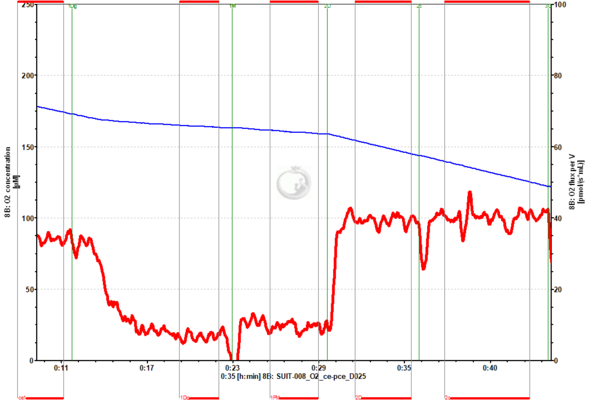Difference between revisions of "Cytochrome c"
| Line 33: | Line 33: | ||
File:cyt_c_traces_O2_flux_03.png | '''Figure 3'''. Cytochrome ''c'' addition (2c) in OXPHOS state (in the presence of pyruvate, glutamate and malate) triggers an increase of the oxygen flux. This high [[Cytochrome c control factor|cytochrome ''c'' effect]] (0.44) may indicate a lost of the outer mitochondrial membrane integrity due to 1) sample preparation or 2) treatment (see [[Cytochrome_c_control_factor#Cytochrome_c_release|cytochrome ''c'' release]]). BAT tissue homogenate from mouse. Experiment 2015-07-09-P2-03. | File:cyt_c_traces_O2_flux_03.png | '''Figure 3'''. Cytochrome ''c'' addition (2c) in OXPHOS state (in the presence of pyruvate, glutamate and malate) triggers an increase of the oxygen flux. This high [[Cytochrome c control factor|cytochrome ''c'' effect]] (0.44) may indicate a lost of the outer mitochondrial membrane integrity due to 1) sample preparation or 2) treatment (see [[Cytochrome_c_control_factor#Cytochrome_c_release|cytochrome ''c'' release]]). BAT tissue homogenate from mouse. Experiment 2015-07-09-P2-03. | ||
File:2019-08-06 P3-02 - A - for cyt c page.png | '''Figure 4'''. Cytochrome ''c'' addition (1c) in OXPHOS state (in the presence of succinate and rotenone) seems to trigger at first a decrease in oxygen flux, and then an increase up to the same levels as before. It is important to wait for the stabilization of the oxygen flux to set the mark, avoiding an artefactual negative [[Cytochrome c control factor|cytochrome ''c'' effect]] (in this case, the cytochrome c control factor was 0.001). Huh 7 cells, permeabilized with digitonin. Experiment 2019-08-06 P3-02. | |||
|- | |- | ||
Revision as of 12:20, 9 July 2020
Description
Cytochrome c is a component of the Electron transfer-pathway (Electron transfer pathway) in mitochondria. It is a small heme protein loosely associated with the outer side of the inner mitochondrial membrane. The heme group of cytochrome c transfers electrons from Complex III to Complex IV. The release of cytochrome c into the cytoplasm is associated with apoptosis. Cytochrome c is applied in HRR to test the integrity of the mitochondrial outer membrane (cytochrome c control factor).
Abbreviation: c
Reference: MiPNet09.12; Gnaiger 2002 Biochem Soc Trans
Application in HRR: storage and stock solution of c
- c: Cytochrome c (from equine heart), Sigma C 7752, 50 mg, store at -20 °C; FW = 12384 Da.
- Preparation of 4 mM cytochrome c solution (dissolved in H2O):
- Weigh 50 mg cytochrome c into a small glass beaker. Difficult to weigh, since the powder is electromagnetic.
- Add 1 mL H2O; c dissolves easily.
- Divide into 0.2 mL portions.
- Store at -20 °C.
- Caution: Chemicals stored in the fridge or freezer should be allowed to reach room temperature before opening.
- O2k manual titrations: MiPNet09.12 O2k-Titrations
- Titration volume: 5 µL using a 25 µL syringe (2 mL O2k-Chamber).
- Final concentration: 10 µM.
DatLab oxygen flux: performance and data analysis
- Quality of the results are strongly affected by the performance and data analysis. By adding cytochrome c in respirometric experiments the outer mitochondrial membrane integrity can be evaluated (cytochrome c control factor). The following DatLab traces illustrate examples of cytochrome c addition:
Figure 1. Cytochrome c addition (2c) in OXPHOS state, using pyruvate and malate as NADH-linked substrates. An increase in oxygen flux per volume (red trace, right axis) can be seen upon cytochrome c addition (cytochrome c control factor=0.09). Cardiac isolated mitochondria from mouse. Experiment 2019-02-19 P1-02 (SUIT-008 O2 mt D026, DatLab 7.4).
Figure 2. Example of cytochrome c addition (2c) in OXPHOS state, in the presence of pyruvate and malate as NADH-linked substrates. The (cytochrome c control factor=0.02) indicates that cryopreservation, sample preparation and the use of the detergent digitonin did not affect the integrity of the outer mitochondrial membrane. Cryopreserved HEK-293 cells. Experiment 2017-02-08 P1-02 (SUIT-008 O2 ce-pce D025, DatLab 7.4).
Figure 3. Cytochrome c addition (2c) in OXPHOS state (in the presence of pyruvate, glutamate and malate) triggers an increase of the oxygen flux. This high cytochrome c effect (0.44) may indicate a lost of the outer mitochondrial membrane integrity due to 1) sample preparation or 2) treatment (see cytochrome c release). BAT tissue homogenate from mouse. Experiment 2015-07-09-P2-03.
Figure 4. Cytochrome c addition (1c) in OXPHOS state (in the presence of succinate and rotenone) seems to trigger at first a decrease in oxygen flux, and then an increase up to the same levels as before. It is important to wait for the stabilization of the oxygen flux to set the mark, avoiding an artefactual negative cytochrome c effect (in this case, the cytochrome c control factor was 0.001). Huh 7 cells, permeabilized with digitonin. Experiment 2019-08-06 P3-02.
- See also: Steady state, Figures 1-3.
- For further information see: » Cytochrome c control factor
- See also: Steady state, Figures 1-3.
- Bioblast links: DatLab performance and data analysis - >>>>>> - Click on [Expand] or [Collapse] - >>>>>>
- Performance
- » Smoothing
- » Reoxygenations
- » Steady state
- » Sample addition
- » ROUTINE
- » ADP
- » Cytochrome c
- » Succinate
- » Oligomycin
- » Uncoupler
- » Rotenone
- » Antimycin A
- » Complex IV
- Performance
- Data analysis
- » Smoothing
- » Reoxygenations
- » Steady state
- » Sample addition
- » ROUTINE
- » ADP
- » Cytochrome c
- » Succinate
- » Oligomycin
- » Uncoupler
- » Rotenone
- » Antimycin A
- » Complex IV
- Data analysis
SUITbrowser question: mt outer membrane integrity
- The cytochrome c test is available at several SUIT protocols. The SUITbrowser shows which protocols contain this test, alongside answer other research questions.
MitoPedia topics:
Substrate and metabolite





